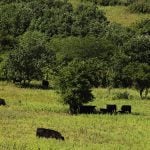Feedlot buying interest appears to be waning at the higher levels as breakeven pen closeout prices on 750-pound-plus feeders continue to creep higher. Upcoming uncertainty in feed grain prices, along with softer wholesale beef values, has the ability to squeeze feeding margins in late summer and feedlot managers are carefully assessing the risk/reward economics.
Alberta packers were buying fed cattle in the range of $146-$148 per hundredweight (cwt), which is about $13/cwt above breakeven prices, but historically, it is not uncommon to experience a price slide into the summer period. The momentum change in the fed cattle market is spilling over into the feeder complex.
Read Also

U.S. grains: Soybeans touch 16-month high, wheat firm on Chinese demand hopes
Chicago soybean futures hit 16-month highs on Monday on expectations China will restart large-scale U.S. soy buying after the two countries reached a deal to de-escalate their trade war.
The high-end range of larger-frame quality featured 800- to 850-pound steers were trading in the range of $175-$185/cwt this past week in southern Alberta but the market appeared to be softer in the non-major feeding regions. Order buyers were idle at times, with market limits tempering the buying enthusiasm that was evident earlier in March. Feedlots are now comfortable with current numbers heading into the summer and pen conditions have deteriorated stemming the tide for fresh feeders. Silage availability is also starting to influence purchasing decisions for certain operations, adding to the cost per pound gain.
While the cow-calf producer finally has a year of equity building under his belt, we usually need one full year of historically high feeder prices to encourage expansion. The low interest rate environment has yet to set into the grassroots arena for cattle production. Farmers are starting to get ready for spring planting, and many are holding their crops from 2013, causing a cash squeeze for buying grassers. Exotic steers weighing 530 lbs. in central Alberta were still selling for $234/cwt, which is a shock for the farmer who paid $160/cwt for the same cattle last year.
The weather trend in the U.S. Midwest is cold and dry. Much of Kansas, Nebraska and Iowa experienced less than 25 per cent of normal precipitation during March. The corn and feed grains markets are bracing for a volatile summer period, which is certainly going to influence North American feeder cattle prices.
— Jerry Klassen is a commodity market analyst in Winnipeg and maintains an interest in the family feedlot in southern Alberta. He writes an in-depth biweekly commentary, Canadian Feedlot and Cattle Market Analysis, for feedlot operators in Canada. He can be reached by email at [email protected] for questions or comments.












